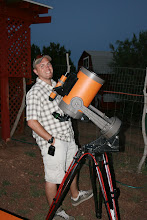Rediscovering Pluto
Working at Lowell Observatory has taught me many things about what astronomy research is like and I feel I am not meant to be a professional astronomer. There is a special art and feeling of triumph when locating an object in the night sky without the use of a computer. Many astronomers have made great discoveries with the aid of technology and I am in no way trying to plead that method of using technology is wrong. The telescope itself is technology so are the new star charts we amateurs all use; however I do find it very flattering when an astronomer asks me where an object is in the night sky. Their professional focused careers can sometimes lead them away from the intimacy of knowing the general night sky. This path of ultimately staying an amateur astronomer has directed me toward education; a far better fit for someone like me.
So what are the requirements of an "Amateur Astronomer?" First, you need a healthy appetite to want to learn about the Universe; maybe you like reading science news articles or watching the Discovery Channel programs about space or maybe you read blogs like this. Once you are gobbling up the facts and enjoy doing so you need to begin learning the sky. This second step I think is the most important and also the obstacle that turns most away from astronomy. There are a lot of stars in the sky and it can be a challenge to learn how to identify the constellations they are in. Start easy and learn in small comfortable steps, it takes time. The third step to becoming an amateur astronomer is to acquire some type of optical equipment like binoculars or a telescope. I recommend to start with binoculars because they are cheaper and if you start to find star clusters and nebulae then move on up to a telescope. Step four, learn to find you favorite objects and gradually add more to your list, also invite people to share these sights with. As far as the general public is concerned you now know more about astronomy then them and you have earned your title as Amateur Astronomer...... but alas there is one more task. It is essentially like getting a PhD in Amateur Astronomy...you must find Pluto and track it for a few nights to make sure it is Pluto.
Pluto is slowly making its way farthest from the Sun and Earth in its orbit. You need very dark skies and close to a 10 inch aperture scope to see it. It is possible to use an 8 inch scope but the optics need to be well aligned and the skies super dark. I started my PhD in Amateur Astronomy in June 2012. Pluto is aligned near the Center of the Milky way making it even more of a challenge. I used Stellarium to see where Pluto would be in relation to other bright objects and then I used the Digital Sky Survey to plot out Pluto's position next to dimmer stars. I was not using a computer to point the telescope I was using a computer to memorize a pattern of about 20 small dots barely visible in my telescope. The first night was the longest I decided to camp out on the historic grounds where Pluto was first discovered at Lowell Observatory. After 2 hours my friend Ian and I were pretty sure we had found it. The trick with Pluto is....you are not sure it's Pluto until you see it move the next night. The next night Pluto was close to a 12th magnitude star and very hard to see. Eventually the next few nights revealed a small moving dot across the background of stars. Pluto is a little less than half the diameter of the United States and almost 4 billion miles away.
Pluto is added in this picture as a red dot that moves from left to right for 5 nights starting on June 13th 2012. The second night when Pluto was parked next to a dim 12th magnitude star Pluto was virtually invisible due to the blinding glare of this star with you see represented as a black dot to the left of Pluto on the second night. As a reference none of the stars in this picture are visible to the unaided human eye. The dimmest star a human can see is a 6th magnitude the Hubble telescope can see around 32nd magnitude. So poor Pluto is about 14th magnitude hence why you cannot observe Pluto dancing in the sky like 5 of the other planets. On the last night I shared this experience with friends and co-workers by placing Pluto in the 116 year old, 24 inch Clark refractor.
An Amateur never stops learning, even the professionals continue to learn. Astronomy only requires patience and clear skies. Good Luck with your journey.



